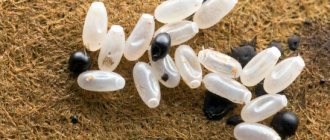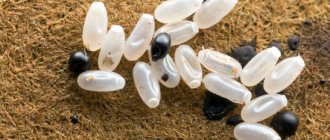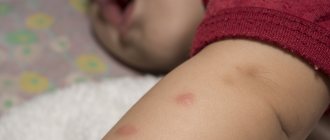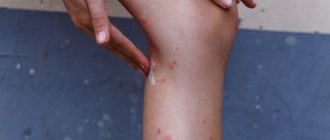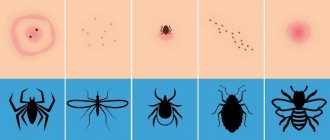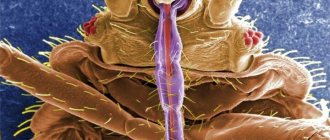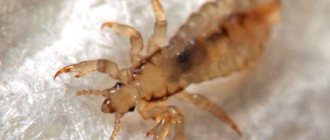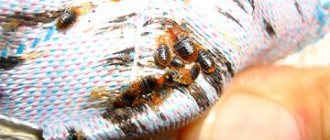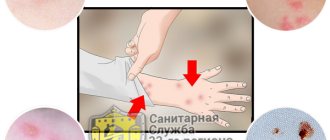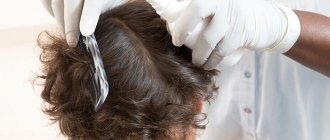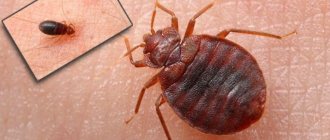Bedbugs are small blood-sucking insects that cause a lot of trouble. They easily get along in rooms of any type and purpose. They leave itchy bites on the body. They are carriers of dangerous diseases. They reproduce quickly, increasing the population regardless of the ambient temperature. Life expectancy is up to 14 – 18 months. Under favorable environmental conditions, the period may increase. They move quickly around the room. They search for the victim by smell and warmth.
Signs of bedbugs in an apartment:
- itchy bites appear on the body;
- traces of vital activity on furniture, wallpaper - dark spots;
- red, dark spots on bed linen - remain after accidental crushing;
- specific smell.
The appearance of bedbugs will also be indicated by insect eggs laid. Finding them is quite difficult on your own. When carrying out disinfestation, it is important to treat all hard-to-reach places. Otherwise, it is the eggs that will cause re-treatment. SES specialists know in which places bedbugs most often lay eggs. They purposefully treat these areas, hard-to-reach places. Thanks to professional work, bedbugs disappear in 1-2 weeks. When pest control is carried out by the service, the probability of relapse is reduced to 0.
How do bedbugs bite?
The bug's mouthparts allow it to reach blood without disturbing humans. The parasite has a proboscis with a special structure. He injects saliva into the wound with an enzyme that prevents blood clotting. The saliva itself has some analgesic effect, so the person does not feel the bite during the entire time the bug is drinking blood. Bedbugs feed on capillary blood, that is, they pierce human skin to a shallow depth. There is not enough blood from one wound; this is not enough for the bug. So he crawls a little further and makes the next puncture. The pest can leave up to five wounds on a person’s body. They are all located nearby and form a path. From these wounds the parasite sucks up to 7 ml of blood. After satiation, he lives for up to 10 days without going out to hunt, then again looks for food. This is how an adult bug feeds. But people are also bitten by larvae, which drink less blood at a time, so they bite more often.
Bedbugs are nocturnal and come out in search of food when a person is sleeping. In extremely rare cases, a bug can bite during the day. This happens if there was no one in the room for a couple of weeks, and then the victim appeared.
Favorable and unfavorable conditions
Bed bugs, whose development stages depend on the microclimate, are very sensitive to environmental temperature and humidity. The most favorable temperature for life is above 16°C. Below this value, adults fall into a state of torpor and can exist like this for a long time. At a temperature of -10°C, adult insects live no more than 5 days, and the larvae die within a few hours. At -32°C, larvae and eggs die instantly, and adults die after 10-15 minutes.
Death temperature
Bedbugs tolerate low air humidity quite well. At a temperature of +35-40°C and low humidity, they survive even after losing 1/3 of the liquid. But the younger the larva is, the more susceptible it is to temperature and humidity. The upper temperature limit for bedbugs is + 45°C.
To get rid of bedbug larvae, you need to freeze or warm bedding, furniture and places where insects hide. Bed bugs do not tolerate high concentrations of CO2, but can feel tolerable in an atmosphere of pure nitrogen. In experiments, they maintained such conditions for 72 hours.
How to identify a bedbug bite
You can understand that parasites have appeared in the house by the characteristic marks on the body. They may be mistaken for allergies or confused with other insect bites. But a bug bite has its own signs:
- several tracks next to each other in the form of a path with a distance of about a centimeter between them;
- you can discern a puncture in the center, around it there is a red swelling with a pronounced halo;
- if you press on the bite, painful sensations appear;
- severe itching.
Also, indirect signs that it was a bug that bitten are small spots of blood on the bed linen. The fact is that during a puncture of the skin, the bug releases saliva with an enzyme through its proboscis, due to which the blood does not clot immediately, that is, some of it flows out and thus leaves marks on the underwear.
Stages of development from egg to adult bedbug
A feature of bed bug reproduction is traumatic fertilization. The male's genital organ has a sharp tip, with which he pierces any part of the female's body. The injected sperm are transported through the hemolymph flow into a special Berlese organ, characteristic only of bed bugs. It is used not only for long-term storage of sperm, but also for regeneration of the female’s body after injury.
With the flow of hemolymph, the seminal fluid migrates into the ovarioles, where the eggs are fertilized. Over the course of its entire life, one female can lay about 500 oblong eggs, equipped with a cap for the larvae to emerge. The number of eggs depends on the amount of sperm entering the body, ambient temperature and nutrition.
Eggs
During the day, the female lays an average of 5 eggs, which in appearance resemble a tiny transparent capsule. A durable sticky shell reliably protects the embryo from external influences and chemicals. Most effective insecticides do not destroy eggs; they can be eliminated either mechanically or using temperature control. Destructive temperatures for bedbugs and oviposition: -20°C, +50°C.
Already 3-4 days after the fertilized eggs are laid, the first generation larvae appear. An adult can live up to a year in favorable temperature conditions. Even one female bedbug is capable of founding a large colony.
Pairing
On the abdominal segments of bedbug larvae there are glands that produce a secretion with a specific odor. In adult parasites, these glands are located on the metathorax. The secret contains:
- pheromones - to attract individuals of the opposite sex;
- indications of the presence of a food object - pheromones of the “food trail”;
- danger warning – alarm pheromones.
The glands also produce kairomones, substances that repel predators. When there is a large population of bedbugs, their specific smell is strongly felt. What is unique is that during feeding, the larvae secrete pheromones that attract “relatives” to the “table”, and when they finish feeding, they release kairomones that repel predators.
One week passes between the next molting of the larva and its transition to the next stage of development. The entire development cycle takes 1-2 months in favorable conditions, and when the temperature drops it can stretch up to 80-100 days.
How does a bedbug bite differ from the bites of other insects?
Bedbug bites are similar to mosquito bites, but, firstly, mosquitoes bite at any time of the day, and not just at night. Secondly, mosquito bite marks appear in different places and are not grouped in one place. They have more vague outlines, the mark left by a mosquito can be very large, and bedbugs are always approximately the same in size.
Wounds caused by ticks differ significantly. A tick leaves one puncture, but bedbugs always leave several or even many. The mark left by a tick is much larger and may not itch at all.
Fleas, unlike bedbugs, bite painfully. Their bites are chaotic and do not follow a smooth path. There are not many of them, mostly they remain on the legs, and the bug bites all over the body.
Wounds after midges differ in appearance. These insects do not pierce the skin, but rather bite off a piece from it. Such wounds take a very long time to heal.
Appearance
The development of the larva in the egg takes about two weeks, depending on temperature conditions. The egg size does not exceed 1 mm. Nymphs of the first instar are born in the same way. In appearance they resemble adult bed bugs, but are lighter in color.
Within a few days the first molt occurs. In the process, the young individual climbs out, grows 1 mm larger, and leaves a skin. Over the course of 20 days, nymphs molt 5 times. At the last stage, the larva increases in size to 5.5 mm. The genital organs are formed and become an adult, ready for reproduction.
Bedbug nymphs at the last stage look almost the same as adult adults, differing in size by 2 mm. There are also other differences.
- What bedbugs and their larvae look like depends on their diet. A hungry bug has a flattened, wide body, gray in color. The insect is active, crawls quickly, is difficult to catch and even more difficult to crush. A photo of bed bug larvae and adults in the fasting stage is presented below.
- Bedbug larvae look slightly different after feeding. The chitinous cover expands as food arrives. The bug takes on a rounded shape, due to this it increases in size. Body color is dirty scarlet. After a few days, the blood coagulates and turns brown. All this is visible through the translucent chitinous cover. Well-fed adults, developing domestic bedbugs are clumsy, vulnerable, bursting at the slightest pressure. A photo of house bug larvae in a well-fed state is presented below.
- Under unfavorable conditions of existence, the larvae and adults fall into suspended animation. Metabolic processes slow down, the body gradually dries out. The insect turns into a living mummy. In this state, it is easy to confuse it with a skin after molting or with a dead bug. The color is gray, almost transparent. But when favorable conditions occur, the insect instantly comes to life and begins active feeding. Nymphs are more resistant to starvation than adults.
- The eggs are white, oblong in shape. However, it is very difficult to see them with the naked eye.
Who is most often bitten by bedbugs?
These pests are exclusively nocturnal and bite people only in bed. They are not afraid of light, meaning sleeping with the lights on to avoid being bitten does not help. Bedbugs will bite even when the light bulb is on.
Bedbugs bite all people, regardless of their gender and age. It is easier for them to pierce delicate skin, so they are more likely to choose a child or woman as a victim than a man. But this does not mean that bedbugs do not bite men. Children and women with sensitive skin are less susceptible to bedbug bites.
When is it necessary to re-treat to destroy all larvae?
Incubation of bed bug eggs lasts 7-12 days, up to a maximum of two weeks in normal home conditions. That is, two weeks after treatment, larvae have already hatched from all eggs and there will be no developing eggs left here.
The larvae themselves develop to adulthood in about 30 days.
This means that re-treatment must be carried out precisely in this time window - no earlier than two weeks after the first disinfestation, but no later than 30 days. If done earlier, there is a risk that at this time there will be single eggs left in the apartment, from which the larvae have not yet hatched, and they will hatch after the second treatment. If carried out later than a month later, then by the time of the second baiting, individual adult bedbugs may already appear in the apartment, which will lay new eggs and, similarly, larvae will hatch from them after the second treatment.
Our practice at DisinCity shows that re-treatment is usually not required. According to our statistics, in 83 cases out of 100, after our first treatment, bedbugs no longer bite people. Only in 17% of cases is there a need for re-processing. In fact, it is required if you were poisoned by bedbugs, but after a week and a half the bites began to appear again. If you are absolutely sure that bedbugs are not getting to you from your neighbors, then these bites are left by small larvae. You can try to find them and if you find them, call the service and carry out repeated disinfestation.
Where do bed bugs bite most often?
The bite occurs on the part of the human body that is closest to the bug. These are not the fastest insects, they do not move very quickly, so they prefer to bite close to their shelter.
If we talk about body parts, bedbugs give preference to those areas of the skin where it is thinnest. The most common people to suffer from bedbugs are:
- legs, especially the inner thighs, as well as the groin;
- hands, especially armpits;
- neck and face;
- skin between the fingers, under the knees;
- back and stomach.
Important: an area of the body must be open during sleep for the bug to bite it. Clothing is an obstacle for bedbugs.
How do parasites bite?
Bedbugs bite their victims at night, even when the lights are on. Parasites are most active between 1-2 am and 6 am.
To understand how bed bugs bite victims, you need to understand the intentions of the pests. The insect's goal is to locate the capillary. The parasite bites through the skin of a person or animal exactly in the place where the artery is located. Insects sense blood very well.
The pest's two-channel trunk ensures simultaneous sucking of blood and injection of anesthetic saliva. The parasite does not stay in one place for long - until it sucks about 1.5 µl of blood. Then he moves a few centimeters to the side.
An adult parasitic individual causes up to 5 damage at a time. After this, the insect eats for 7-10 days. The adult continues to eat for 20-25 minutes, the young eat only 3-4 minutes.
Can bedbugs bite through clothes?
A bedbug can crawl under clothing or underwear to bite a person. But he simply cannot bite through clothes. The maximum length of the proboscis is 0.7 mm. This is very small and much less than the thickness of even the thinnest fabric. He simply won’t reach the skin through clothes. In addition, many of the fabrics from which sleepwear is made have a denser structure due to the interweaving of fibers than human skin, so a bug will not even be able to pierce them. Therefore, he will bite an open area of the body: wrists, ankles, face, neck.
Popular questions
In conclusion, it would not be amiss to answer a number of the most popular questions within the topic.
What should you do to prevent bedbugs from biting at night?
An effective method of preventing bedbug bites is extermination of insects. The most effective method in this regard is baiting parasites using chemicals; traditional methods do not kill or repel bedbugs.
You need to start getting rid of pests immediately after they are identified, since bedbugs reproduce very quickly. The female lays 5 eggs daily; over the lifetime of a female, she will produce about 500 eggs.
Under favorable conditions, young animals will be able to reproduce within 40 days.
Where do bedbugs usually bite?
Bedbugs tend to choose a place on the victim’s body with the softest and thinnest skin in order to easily and quickly reach the artery.
Insects usually prioritize exposed areas of the body: arms, neck, lower limbs, face and back.
However, this does not mean that parasites are not capable of infecting the stomach, groin, and armpits - they can end up under blankets or clothes in the absence of open areas.
When do bedbugs bite most often?
Typically, insects “go hunting” at night.
Peak activity of parasites occurs between 1-2 am and 6 am.
How long do couch bug bites last?
Most often, the wound disappears within a day. In uncomplicated cases of a bite from a person with a weakened immune system, bedbug lesions disappear after 7-14 days. For allergy sufferers, this process is delayed for several weeks.
Do bed bugs bite during the day?
Typically, bedbugs feed on blood at night and hide during the day. Only debilitating hunger can force the parasite to “go hunting” during the day, for example, if the family has been away from home for three weeks and lies down to rest.
Can a bedbug bite through clothing?
Insects do not bite through items of clothing; they cannot even bite through thin tights, not to mention a jacket or pants.
Accordingly, bedbugs prefer to “hunt” on open areas of the victim’s body.
Is there any harm from bed bug bites?
These parasites, when compared with other insects, are among the most harmless. They extremely rarely carry pathogens of dangerous diseases and do not cause serious health problems. Bite marks go away quite quickly and do not leave scars. The mark appears approximately 1.5 - 2 hours after the bite. First, a chain of red spots appears, then they are accompanied by severe itching. If you don't scratch the wounds, they will go away on their own within a week. The swelling will go away, the itching will stop, and spots will not remain on the skin.
A variety of domestic bedbug larvae
Initially, a small bug is visually almost invisible. Its body length is only about 1.5 ml. It takes a week to move to the next stage of development. The larva is growing. The shell becomes too small. She throws it off. It becomes light in color again, and after a few minutes it is already 2.5 ml long in a dark color. You can already see such a bug. It has 3 pairs of legs, a flat body, and long antennae on its head. The color also changes depending on food. Since the blood has a rich scarlet color, and the insect’s cover is translucent, after a meal the larva becomes almost red. After a while, the blood coagulates, and by the end of the week the bug is gray-brown in color. The shedding process is not as simple as it seems. Many larvae fail to cope with this task and die without ever getting out. Those who are lucky are looking for a power source again.
After each molt, the larva increases by 1-2 ml. At the end of its development, the body reaches a length of 6 ml. Moreover, the female is always larger than the male. The entire process of larval development from the moment of birth takes about a month. It develops in the egg for a week. The development of an insect is influenced by food and temperature conditions. At low temperatures, development slows down. The larva does not move on to the next stage of its development; the adult bug appears much later - 2-6 months.
How to relieve itching
It's no use scratching. Firstly, this only helps for a while, and secondly, scratching damages the skin, the wound becomes larger and takes longer to heal. You can accidentally introduce some kind of infection into scratching and harm yourself even more.
To reduce itching, you can use essential oils with a cooling effect, make a cool compress, or lubricate the area with special anti-itch ointments or gels.
If there are a lot of bites, an allergic reaction to them may occur. To reduce discomfort, you should take antihistamines. It is advisable to consult a doctor for a prescription.
Treatment
Next, we’ll look at how you can treat bedbug bites on the human body. If you find bite marks, do not panic and scratch the wounds. Otherwise, the development of a purulent inflammatory process is possible.
The first stage of treatment for sofa bug bites is first aid.
In the first minutes after identifying the affected areas, it is necessary to wash the bite site with clean water and soap. Mild soap should be used. You can use foam: soap your palms until a lush foam forms, apply it to the bite area in a dense layer.
You should not wash off the soap composition right away - it is better to wait until it dries. Usually the measures described are sufficient to eliminate primary itching.
ethnoscience
If you are bitten by a bug, you can limit yourself to available means of therapy that help relieve the primary symptoms (itching, swelling, redness):
- mint leaves are applied to the damaged area (the plant can be replaced with parsley) - the pain “goes away”, the skin relaxes;
- crush dandelion and apply it to the damaged area of the skin - swelling decreases;
- the bite sites are treated with urine (using a cotton pad or sponge) - bedbug bites stop itching;
- gauze soaked in garlic juice is applied to the itchy skin - irritation is eliminated and swelling is reduced;
- A plantain (cherry) leaf is applied to the affected area and left for 3 hours, after which the skin is wiped with a soda solution - the symptoms of an allergic reaction are eliminated.
Attention! If blisters appear in the bite area, you can treat the skin with toothpaste containing mint or ammonia.
The composition must be pre-mixed with water (proportion 1:1).
Drug therapy
In some cases, treatment of bedbug bites cannot be done without the use of medications. Under such circumstances, an anti-inflammatory steroid ointment is applied to the affected area, which can be purchased at a pharmacy without a prescription.
Among the representatives of the medicinal group, Cortade stands out - a drug based on hydrocortisone and cortisone that reduces itching and inflammation.
As an alternative, calamine lotion . Simply apply the product to the bite site and do not wash it off - the itching will be moderated, the rash will dry out, and the skin will be protected until complete recovery.
For severe allergic reactions, antihistamines, such as Benadryl, are taken. It is acceptable to use any antihistamine ointment that is used to treat a bug bite.
If the patient is bothered by severe pain, he cannot do without painkillers - anti-inflammatory tablets, for example Ibuprofen, Aspirin. The first drug acts on the principle of reducing the concentration of hormones that stimulate inflammation, fever and pain.
Acetylsalicylic acid is able to block pain signals, preventing them from entering the brain.
Attention! Aspirin can also be taken at elevated temperatures; however, it should not be used when treating children. To relieve your child's symptoms, you can use Tylenol, a non-steroidal anti-inflammatory drug.
When is it necessary to see a doctor immediately?
If redness on the skin does not go away within two weeks, the bitten person should be shown to a doctor.
Emergency medical care is indicated for the patient in the following cases:
- multiple bites are visualized;
- blisters form;
- symptoms of an infectious process are observed (hypersensitivity, discharge);
- pronounced signs of an allergic reaction of the body (redness, swelling, rash) appear.
Consequences and complications
It is also worth answering the question of why bedbug bites are dangerous. Conducted epidemiological studies have not proven the fact that insects transmit viruses dangerous to human life.
Insect bites are especially dangerous for people who suffer from hypersensitivity to the enzyme secreted by parasites.
In such patients, contact with the pest can cause anaphylactic shock and Quincke's edema.
Other unpleasant consequences that can be expected when bedbugs bite include:
- severe allergic reaction to bedbug bites (observed in 80% of victims);
- severe itching and pain;
- suppuration, development of inflammation, skin erosion (when scratching wounds);
- diagnosing anemia in a newborn, elderly patient, child (in case of mass insect infestation);
- the development of a disease carried by the parasite;
- hyperthermia, migraines, loss of consciousness.
Attention! The described possible consequences of bites are rarely observed. In most cases, they cause symptoms similar to mosquito bites. In the case of bed bugs, the victim complains more about mental disorders.
Consequences of bites
Apart from itching, bedbugs do not cause any other serious problems. They do not carry infectious diseases, since the pathogens do not live in the body of the bug. The main danger is allergic reactions. In addition to skin rashes, edema, and swelling, they can be expressed, for example, as Quincke's edema, and this is already very dangerous. Another unpleasant consequence is irritability and sleep disturbances due to constant itching. This can lead to nervous disorders and serious problems. Therefore, it is necessary to fight bedbugs. They will not leave on their own, because any apartment has ideal conditions for these insects: warmth, normal humidity and constant access to food. You can destroy bedbugs with special insecticides from or by inviting specialist pest control services to your home.
An effective remedy for fighting bedbugs produced by the Medilis Laboratory company is the Medilis-ANTICLOP spray (insecticide). This product is safe for humans, its advantage is:
- Combinations of three active ingredients;
- Acts on resistant populations of bedbugs;
- Duration of action is more than 60 days;
- The product is ready for use (does not need to be diluted with water);
- One-time treatment = 100% effectiveness.
Where do parasite larvae hide?
The bedbug is a heat-loving creature. The insect does not tolerate drafts, high humidity, or bright light. Always hides in a dark, warm place. Since the source of food is a sleeping person, they build their nest in the bedroom. In case of severe infestation, they can settle in another part of the room. The most typical place where larvae hide is a bed, mattress, sofa. Small creatures crawl into the joints of furniture, bed frames, seams, and folds of the soft part of the bed. But don't delude yourself. Parasites can be more sophisticated and hide anywhere:
- from the back of the furniture;
- in canteens, shelves;
- books;
- toys;
- paintings;
- decor items;
- carpets;
- photographs;
- hours;
- household appliances;
- lamps;
- in sockets;
- under the wallpaper;
- laminate;
- in flower pots.
To find the nest, you will have to work hard and turn the entire apartment upside down.
Precautionary measures
Getting bedbugs is easy, but getting rid of them is incredibly difficult.
By the way, you can read about why bedbugs appear in an apartment in a separate article!
Therefore, you need to follow a few basic tips:
- Chat with people living in your neighborhood. Bedbugs are excellent travelers. They always manage to quickly find comfortable living conditions. Using ventilation, insects find new victims. Ask your neighbors (not intrusively) if they have any difficulties in this regard. Awareness is the key to caution.
- Carry out wet cleaning more often. It is useful to walk across the floor with a mop, work with sponges and rags, get rid of dust, and beat out carpets. This way you can not only improve the room, make it clean, but also get rid of ill-wishers.
- Pay attention to the characteristic signs of the appearance of bloodsuckers. The unpleasant smell of cheap cognac, black dots on the wall, round bite marks on the body are evidence of unwanted roommates.
How long does it take for the bite to appear and how long does it last?
When choosing a food source, bed bugs prefer to bite children and women, since they have thin skin, which means it is much easier to get blood. The body's reactions to a bite are also more pronounced. After a couple of hours, inflammation appears in the form of a series of red spots in the shape of a chain and itching begins, which goes away within a few hours.
People with a pronounced sensitivity of the body to bedbug enzymes injected into a puncture may notice red rashes within an hour after the bite. Sometimes there may be no reaction to bites at all.
Treating the bite
If you do not scratch the wounds, then by the end of the first week the redness will disappear and the swelling will subside. And during the second week the puncture mark will heal. The process can be accelerated by using special ointments.
